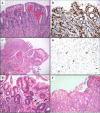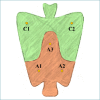Gastritis: update on etiological features and histological practical approach
- PMID: 33179619
- PMCID: PMC7931571
- DOI: 10.32074/1591-951X-163
Gastritis: update on etiological features and histological practical approach
Abstract
Gastric biopsies represent one of the most frequent specimens that the pathologist faces in routine activity. In the last decade or so, the landscape of gastric pathology has been changing with a significant and constant decline of H. pylori-related pathologies in Western countries coupled with the expansion of iatrogenic lesions due to the use of next-generation drugs in the oncological setting. This overview will focus on the description of the elementary lesions observed in gastric biopsies and on the most recent published recommendations, guidelines and expert opinions.
Keywords: H. pylori; endoscopy; gastritis; secondary prevention; staging.
Copyright © 2020 Società Italiana di Anatomia Patologica e Citopatologia Diagnostica, Divisione Italiana della International Academy of Pathology.
Conflict of interest statement
The Authors declare no conflict of interest.
Figures





References
-
- Van Zanten SJ, Dixon MF, Lee A. The gastric transitional zones: neglected links between gastroduodenal pathology and helicobacter ecology. Gastroenterology 1999;116:1217-29. https://doi.org/10.1016/s0016-5085(99)70025-9 10.1016/s0016-5085(99)70025-9 - DOI - PubMed
-
- Hunt RH, Camilleri M, Crowe SE, et al. . The stomach in health and disease. Gut 2015;64:1650-68. https://doi.org/10.1136/gutjnl-2014-307595 10.1136/gutjnl-2014-307595 - DOI - PMC - PubMed
-
- Marshall BJ, Warren JR. Unidentified curved bacilli in the stomach of patients with gastritis and peptic ulceration. Lancet. 1984;1(8390):1311-5. https://doi.org/10.1016/s0140-6736(84)91816-6 10.1016/s0140-6736(84)91816-6 - DOI - PubMed
-
- Okuda M, Sugiyama T, Fukunaga K, et al. . A strain-specific antigen in Japanese Helicobacter pylori recognized in sera of Japanese children. Clin Diagn Lab Immunol 2005;12:1280-4. https://doi.org/10.1128/CDLI.12.11.1280-1284.2005 10.1128/CDLI.12.11.1280-1284.2005 - DOI - PMC - PubMed
Publication types
MeSH terms
LinkOut - more resources
Full Text Sources

